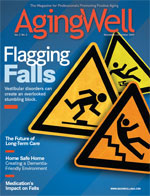November/December 2009 Nutrition for Bone Health Got milk? Then you’ve got strong bones, right? When it comes to keeping bones strong and preventing life-threatening fractures, a wealth of scientific studies points to more than just dairy foods. Defining Osteoporosis More formally, according to the Washington, DC-based National Osteoporosis Foundation, “Osteoporosis, or porous bone, is a disease characterized by low bone mass and structural deterioration of bone tissue, leading to bone fragility and an increased susceptibility to fractures, especially of the hip, spine, and wrist, although any bone can be affected.” There are influences other than osteoporosis that can also harm bones, says Frechman. “Too little vitamin D can cause bone deformities. Kidney disease, Paget’s disease of the bone, and endocrine disorders can also cause bone disease.” An estimated 44 million Americans, or 55% of people aged 50 and older, have osteoporosis, making it a major public health threat, according to National Osteoporosis Foundation statistics. Nutrition Recommendations “Getting the recommended amount of calcium and vitamin D is essential,” says Frechman. “At age 50, the calcium requirement goes from 1,000 to 1,200 mg a day, and most people don’t even get the 1,000 mg daily.” Calcium is found in numerous foods, with dairy products such as milk, yogurt, and cheese among the richest sources. The USDA’s Food Guide Pyramid recommends two to three servings of dairy products per day. An 8-oz cup of low-fat milk (302 mg of calcium) at breakfast, 1 1/2 oz of shredded cheddar cheese (306 mg) on a sandwich at lunch, and an 8-oz container of low-fat fruited yogurt (245 to 385 mg, depending on the brand) before bed would provide an average of more than 900 mg of calcium daily in easy-to-eat forms. Certain green vegetables contain calcium in smaller amounts. A 1 1/2-cup serving of cooked kale and a 2 1/4-cup serving of cooked broccoli, for example, both provide the same amount of calcium as an 8-oz glass of milk. Spinach contains calcium, but it is also a source of oxalic acid, a substance that prevents calcium from being absorbed into the body. Collard greens, sweet potatoes, rhubarb, and beans also contain oxalic acid. Other foods that supply calcium include salmon with the bones, tofu (made with calcium sulfate), and corn tortillas. A variety of calcium-fortified foods, such as fruit juices and cereals, are available at the supermarket. But excessive intakes of dietary protein, phosphorus (in soft drinks), salt, caffeine, and alcohol have been linked to the loss of calcium from the body. Vitamin D is also important for bone health. “Vitamin D increases the absorption of calcium. After age 50, the vitamin D requirement increases from 200 to 400 IUs [international units]. After 70 years, 600 IUs of vitamin D are needed daily,” says Frechman. There are few foods that naturally contain vitamin D, but those that do include fish such as salmon, tuna, and mackerel. Small amounts of vitamin D are also found in beef liver, cheese, and egg yolks. Fortified foods provide the bulk of vitamin D in the diet such as milk, some brands of ready-to-eat breakfast cereals, orange juice, margarine, and yogurt. In addition to foods, says Frechman, “Sunshine is a good place to get vitamin D.” Season, geographic latitude, time of day, cloud cover, smog, skin melanin content, and sunscreen are among the factors that affect ultraviolet radiation exposure and vitamin D synthesis in the skin. “If older adults aren’t getting enough calcium from the food in their diet, they should take a calcium and vitamin D supplement,” Frechman notes. When choosing a calcium supplement, the National Osteoporosis Foundation recommends avoiding those in which the calcium comes from bone meal, dolomite, or unrefined oyster shells because these may contain lead or other toxic metals. Look for supplements designated as “USP” by the U.S. Pharmacopeia, an official public standards–setting authority for all prescription and over–the–counter medicines and other healthcare products manufactured or sold in the United States. Also, look for a calcium supplement that contains vitamin D. Calcium from food or supplements is best taken in smaller amounts throughout the day rather than in one large dose. Other nutrients, such as vitamin C, may also protect bone health, especially in men. Results of the Framingham Osteoporosis Study that were reported in 2008 indicate that vitamin C intake via fruits and vegetables appears to protect against bone mineral density loss in two areas of the hip among men with a low calcium or vitamin E intake. Good sources of vitamin C include citrus fruits, strawberries, tomatoes, sweet red peppers, broccoli, and potatoes. Exercise Weight-bearing exercises are those that force the body to work against gravity. They include lifting weights, walking, hiking, jogging, climbing stairs, playing tennis, and dancing. And exercise offers added benefits for older adults. Physical fitness can reduce the risk of fracture because better balance, muscle strength, and agility make falls less likely to occur. — Carol M. Bareuther, RD, is a St. Thomas, U.S. Virgin Islands-based writer who contributes to a variety of regional, national, and international publications. |

